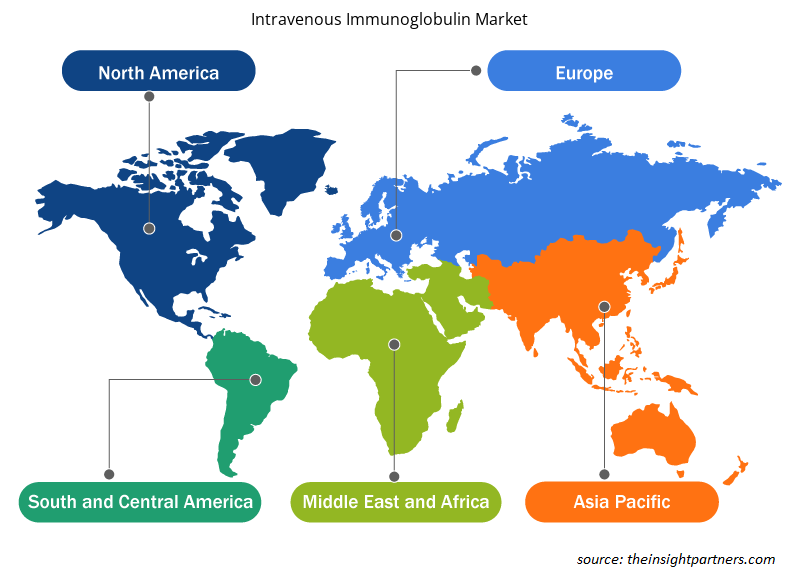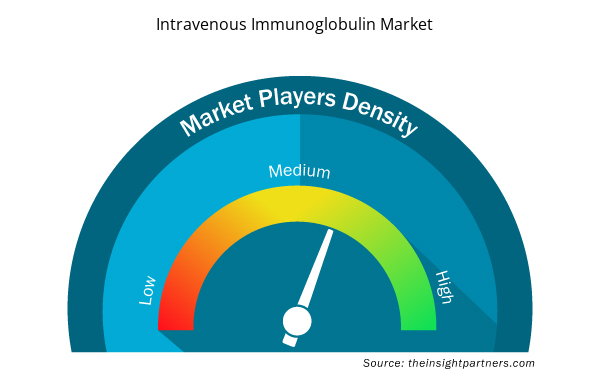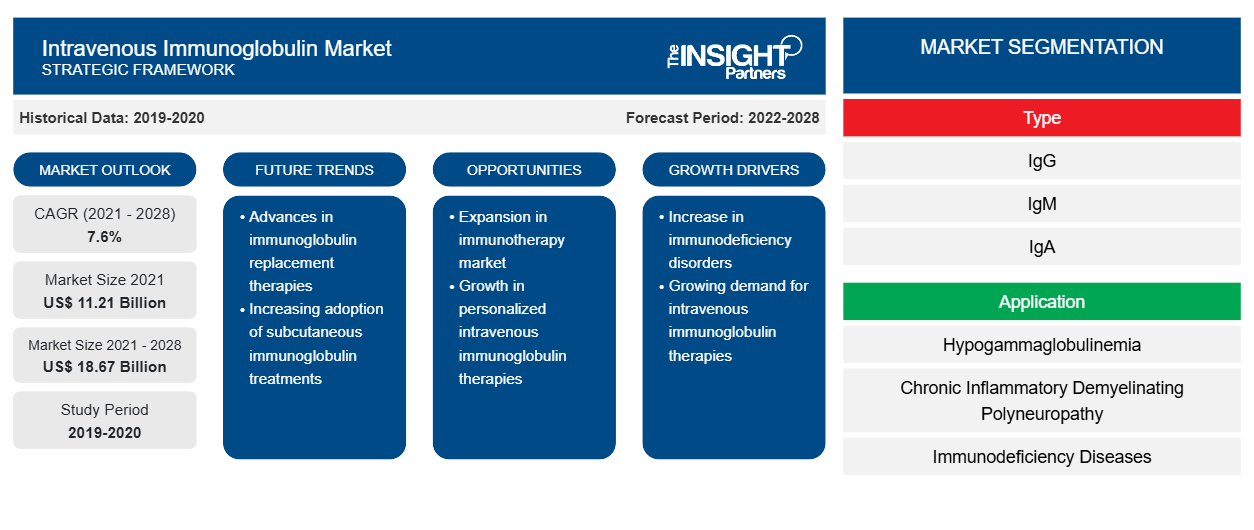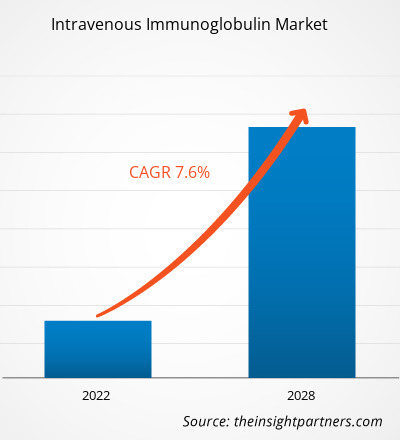Der Markt für intravenöse Immunglobuline hatte im Jahr 2021 einen Wert von 11.206,54 Millionen US-Dollar und wird voraussichtlich bis 2028 einen Wert von 18.672,55 Millionen US-Dollar erreichen; von 2022 bis 2028 wird ein durchschnittliches jährliches Wachstum von 7,6 % erwartet.
Immunglobuline sind Antikörper, die vom Immunsystem des Körpers auf natürliche Weise produziert werden und bei der Bekämpfung von Infektionen und Krankheiten helfen. Bei einem Immunglobulinmangel ist die externe Verabreichung von Immunglobulin erforderlich. Dies wird als Immunglobulinersatztherapie (IgRT) bezeichnet. IgRT kann intravenös und subkutan verabreicht werden. Intravenöses Immunglobulin (IVIg) und subkutanes Immunglobulin (SCIg) werden je nach Indikation und Schweregrad ausgewählt. IVIg wird aus menschlichem Plasma hergestellt. Es enthält Antikörper und wird zur Behandlung einer wachsenden Zahl immunologischer, hämatologischer und neurologischer Erkrankungen eingesetzt.
Der Markt für intravenöse Immunglobuline ist nach Typ, Anwendung, Vertriebskanal, Endverbraucher und Geografie segmentiert. Geografisch ist der Markt grob in Nordamerika, Europa, Asien-Pazifik, den Nahen Osten und Afrika sowie Süd- und Mittelamerika segmentiert. Dieser Bericht bietet Einblicke und eine eingehende Analyse des Marktes und betont Parameter wie Markttrends, Marktdynamik und die Wettbewerbsanalyse der weltweit führenden Marktteilnehmer.
Passen Sie diesen Bericht Ihren Anforderungen an
Sie erhalten kostenlos individuelle Anpassungen an jedem Bericht, einschließlich Teilen dieses Berichts oder einer Analyse auf Länderebene, eines Excel-Datenpakets sowie tolle Angebote und Rabatte für Start-ups und Universitäten.
- Holen Sie sich die wichtigsten Markttrends aus diesem Bericht.Dieses KOSTENLOSE Beispiel umfasst eine Datenanalyse von Markttrends bis hin zu Schätzungen und Prognosen.
Markteinblicke
Die zunehmende Verbreitung von Immunschwächekrankheiten und die Zunahme geriatrischer Bevölkerung treiben den Markt für intravenöse Immunglobuline an.
Laut dem National Institute of Allergy and Infectious Diseases (NIAID) leiden in den USA etwa 500.000 Menschen an über 200 verschiedenen Arten primärer Immundefizienzerkrankungen (PIDDs). Diese seltenen genetischen Erkrankungen können chronisch, schwach und kostspielig sein. Immunthrombozytopenie (ITP) ist eine Autoimmunblutungsstörung, die durch eine ungewöhnlich niedrige Anzahl von Blutplättchen gekennzeichnet ist; ein Zustand, der als Thrombozytopenie bezeichnet wird. Laut der Organisation für seltene Krankheiten werden weltweit jährlich etwa 200.000 ITP-Fälle registriert. Laut World Population Prospects 2019 der Bevölkerungsabteilung der Vereinten Nationen haben asiatische und europäische Länder außerdem einige der ältesten Bevölkerungen der Welt im Alter von 65 Jahren und älter. Japan liegt mit 28 % an der Spitze, gefolgt von Italien mit 23 %. Darüber hinaus gehören Finnland, Portugal und Griechenland zu den fünf Ländern mit einem überalterten Bevölkerungsanteil von unter 22 %. Viele der mit IVIG behandelten Patienten sind über 60 Jahre alt. Mit zunehmendem Alter nimmt die Fähigkeit, T-Zellen zur Bekämpfung von Krankheiten zu produzieren, erheblich ab. Daher ist der Körper älterer Menschen anfälliger für verschiedene Infektionen und Krankheiten, was die Nachfrage nach Immuntherapien mit IVIg erhöht. Der Anstieg von Immunschwächekrankheiten und die weltweite Zunahme geriatrischer Bevölkerungsgruppen stärkt daher den Markt für intravenöse Immunglobuline.
Typbasierte Erkenntnisse
Basierend auf dem Typ ist der Markt für intravenöse Immunglobuline in IgG, IgM, IgA, IgE und IgD unterteilt. Das Segment der Immunglobuline vom Typ IgG hatte im Jahr 2021 den größten Marktanteil. Es wird jedoch erwartet, dass das Segment der Handheld-Geräte im Prognosezeitraum die höchste CAGR verzeichnet, da IgG dort weit verbreitet zur Behandlung mehrerer Krankheitskategorien eingesetzt wird.
Anwendungsbasierte Erkenntnisse
Basierend auf der Anwendung ist der Markt für intravenöse Immunglobuline segmentiert in Hypogammaglobulinämie, chronisch entzündliche demyelinisierende Polyneuropathie, Immunschwächekrankheiten, Myasthenia gravis , multifokale motorische Neuropathie, idiopathische thrombozytopenische Purpura, entzündliche Myopathien, spezifischer Antikörpermangel, Guillain-Barré-Syndrom und andere. Im Jahr 2021 hielt das Segment der Immunschwächekrankheiten den größten Marktanteil. Darüber hinaus wird erwartet, dass das gleiche Segment aufgrund der steigenden Prävalenz von Immunschwächekrankheiten und der zunehmenden FDA-Zulassungen für IVIg-Produkte zur Behandlung von Immunschwäche von 2022 bis 2028 ein Nachfragewachstum mit der höchsten CAGR verzeichnen wird.
Einblicke basierend auf Vertriebskanälen
Basierend auf den Vertriebskanälen ist der Markt für intravenöse Immunglobuline in Krankenhausapotheken, Einzelhandelsapotheken und andere unterteilt. Im Jahr 2021 hielt das Segment der Krankenhausapotheken den größten Marktanteil. Darüber hinaus wird erwartet, dass das Segment der Einzelhandelsapotheken von 2022 bis 2028 aufgrund der Expansion der Einzelhandelsapotheken und der Verlagerung des Verbraucherverhaltens hin zu organisierten Einzelhandelsapotheken, die hochwertige Medikamente und Arzneimittel anbieten, das schnellste CAGR-Wachstum verzeichnen wird.
Endbenutzerbasierte Erkenntnisse
Basierend auf dem Endverbraucher ist der Markt für intravenöse Immunglobuline in Krankenhäuser, Fachkliniken und andere unterteilt. Im Jahr 2021 hielt das Krankenhaussegment den größten Marktanteil. Darüber hinaus wird erwartet, dass das Segment der Fachkliniken von 2022 bis 2028 aufgrund der Fortschritte in den Fachkliniken bei der Bereitstellung einer schnellen und genauen IgRT für Patienten das schnellste Nachfragewachstum mit einer CAGR verzeichnen wird.CAGR from 2022 to 2028, owing to the advances in specialty clinics for offering quick and accurate IgRT to patients.
Organische Entwicklungen wie Produktzulassungen sind von den globalen Akteuren auf dem Markt für intravenöse Immunglobuline häufig genutzte Strategien. Nachfolgend sind einige der jüngsten wichtigen Marktentwicklungen aufgeführt:
- Im März 2022 gab ADMA Biologics, Inc. die Genehmigung der US-amerikanischen Food and Drug Administration (FDA) bekannt, das Verfallsdatum für seine bei 2–8 °C gelagerten Immunglobulin-Arzneimittel ASCENIV und BIVIGAM („IG“) von 24 auf 36 Monate zu verlängern. Die Verlängerung des Verfallsdatums gilt für alle bestehenden ASCENIV- und BIVIGAM-Chargen, die sich derzeit in der kommerziellen Lieferkette befinden, sowie für die zukünftige Produktion von ASCENIV und BIVIGAM in allen Fläschchengrößen, Produktionsmaßstäben sowie für intern und extern abgefüllte Fertigarzneimittel.
- Im Juni 2021 gab Octapharma bekannt, dass Octagam 10 %, ein intravenöses Immunglobulin (IVIg) aus menschlichem Plasma, kürzlich in der Europäischen Union (EU) als immunmodulatorische Therapie für Erwachsene mit Dermatomyositis zugelassen wurde. Nach der EU-Zulassung erhielt Octagam 10 % am 11. Mai 2021 die nationale Zulassung in Deutschland, und die Zulassung in anderen europäischen Mitgliedsstaaten wird bald erwartet.IVIg), has recently been granted approval in the European Union (EU) as an immunomodulatory therapy for adults with dermatomyositis. Following the EU approval, octagam 10% received national approval in Germany on May 11, 2021, with approval in other European member states expected soon.
- Im April 2021 gab ADMA Biologics, Inc. bekannt, dass die US-amerikanische Food and Drug Administration („FDA“) den erweiterten Herstellungsprozess des Unternehmens genehmigt hat, der die Fraktionierung und Reinigung eines 4.400 Liter großen Plasmapools für die Herstellung von intravenösem Immunglobulin („IVIG“) ermöglicht.
- Im Februar 2020 gab CSL Behring bekannt, dass die US-amerikanische Food and Drug Administration (FDA) Privigen (Intravenöses Immunglobulin (Human), 10 % Flüssigkeit) den Orphan-Drug-Status als Prüfpräparat zur Behandlung der systemischen Sklerose (SSc) verliehen hat.
Solche Entwicklungen der Marktteilnehmer treiben den Markt für intravenöse Immunglobuline an.
Regionale Einblicke in den Markt für intravenöse Immunglobuline
Die regionalen Trends und Faktoren, die den Markt für intravenöse Immunglobuline während des Prognosezeitraums beeinflussen, wurden von den Analysten von Insight Partners ausführlich erläutert. In diesem Abschnitt werden auch die Marktsegmente und die Geografie für intravenöse Immunglobuline in Nordamerika, Europa, im asiatisch-pazifischen Raum, im Nahen Osten und Afrika sowie in Süd- und Mittelamerika erörtert.

- Erhalten Sie regionale Daten zum Markt für intravenöse Immunglobuline
Umfang des Marktberichts zu intravenösen Immunglobulinen
| Berichtsattribut | Details |
|---|---|
| Marktgröße im Jahr 2021 | 11,21 Milliarden US-Dollar |
| Marktgröße bis 2028 | 18,67 Milliarden US-Dollar |
| Globale CAGR (2021 - 2028) | 7,6 % |
| Historische Daten | 2019-2020 |
| Prognosezeitraum | 2022–2028 |
| Abgedeckte Segmente | Nach Typ
|
| Abgedeckte Regionen und Länder | Nordamerika
|
| Marktführer und wichtige Unternehmensprofile |
|
Marktteilnehmerdichte für intravenöse Immunglobuline: Auswirkungen auf die Geschäftsdynamik verstehen
Der Markt für intravenöse Immunglobuline wächst rasant, angetrieben durch die steigende Nachfrage der Endnutzer aufgrund von Faktoren wie sich entwickelnden Verbraucherpräferenzen, technologischen Fortschritten und einem größeren Bewusstsein für die Vorteile des Produkts. Mit steigender Nachfrage erweitern Unternehmen ihr Angebot, entwickeln Innovationen, um die Bedürfnisse der Verbraucher zu erfüllen, und nutzen neue Trends, was das Marktwachstum weiter ankurbelt.
Die Marktteilnehmerdichte bezieht sich auf die Verteilung der Firmen oder Unternehmen, die in einem bestimmten Markt oder einer bestimmten Branche tätig sind. Sie gibt an, wie viele Wettbewerber (Marktteilnehmer) in einem bestimmten Marktraum im Verhältnis zu seiner Größe oder seinem gesamten Marktwert präsent sind.
Die wichtigsten auf dem Markt für intravenöse Immunglobuline tätigen Unternehmen sind:
- Takeda Pharmaceutical Company Limited
- Grifols, SA
- Pfizer Inc.
- ADMA Biologics Inc.
- Bio Products Laboratory Ltd.
Haftungsausschluss : Die oben aufgeführten Unternehmen sind nicht in einer bestimmten Reihenfolge aufgeführt.

- Erhalten Sie einen Überblick über die wichtigsten Akteure auf dem Markt für intravenöse Immunglobuline
Intravenöses Immunglobulin – Marktsegmentierung
Der globale Markt für intravenöse Immunglobuline ist nach Typ, Anwendung, Vertriebskanal, Endverbraucher und Geografie segmentiert. Basierend auf dem Typ ist der Markt in IgG, IgM, IgA, IgE und IgD segmentiert. Nach Anwendung ist der Markt in Hypogammaglobulinämie, chronisch entzündliche demyelinisierende Polyneuropathie, Immunschwächekrankheiten, Myasthenia gravis, multifokale motorische Neuropathie, idiopathische thrombozytopenische Purpura, entzündliche Myopathien, spezifischer Antikörpermangel, Guillain-Barré-Syndrom und andere segmentiert. Basierend auf dem Vertriebskanal ist der Markt in Krankenhausapotheken, Einzelhandelsapotheken und andere segmentiert. Nach Endverbraucher ist der Markt in Krankenhäuser, Fachkliniken und andere segmentiert. Nach Geografie ist der Markt in Nordamerika, Europa, Asien-Pazifik, Naher Osten und Afrika sowie Süd- und Mittelamerika segmentiert.
Firmenprofile
- Takeda Pharmaceutical Company Limited
- Grifols, SA
- Pfizer Inc.
- ADMA Biologics Inc.
- Bio Products Laboratory Ltd.
- Shanghai RAAS
- Octapharma AG
- Kedrion SpA
- CSL Behring (CSL Limited)
- Prothya Biosolutions BV
- Historische Analyse (2 Jahre), Basisjahr, Prognose (7 Jahre) mit CAGR
- PEST- und SWOT-Analyse
- Marktgröße Wert/Volumen – Global, Regional, Land
- Branche und Wettbewerbsumfeld
- Excel-Datensatz



Report Coverage
Revenue forecast, Company Analysis, Industry landscape, Growth factors, and Trends

Segment Covered
This text is related
to segments covered.

Regional Scope
North America, Europe, Asia Pacific, Middle East & Africa, South & Central America

Country Scope
This text is related
to country scope.
Häufig gestellte Fragen
The intravenous immunoglobulin market majorly consists of the players such as Takeda Pharmaceutical Company Limited; Grifols, S.A.; Pfizer Inc.; ADMA Biologics Inc.; Bio Products Laboratory Ltd.; Shanghai RAAS; Octapharma AG; Kedrion S.p.A; CSL Behring (CSL Limited); and Prothya Biosolutions B.V.
Based on geography, the APAC region is accounted for highest CAGR in intravenous immunoglobulin market during the forecast period.
The IgG segment under type segment, held the largest share in 2021.
Immunoglobulins are the antibodies produced naturally by the body’s immune system, which help fight infection and disease. The deficiency of immunoglobulin requires the external administration of immunoglobulin and known as immunoglobulin replacement therapy (IgRT). IgRT can be given intravenously and subcutaneously. Intravenous immunoglobulin (IVIg) and subcutaneous immunoglobulin (SCIg) are selected based on the indication and severity. IVIg is manufactured from human plasma. It contains antibodies and is used in the treatment of a growing number of immunologic, hematologic and neurologic illnesses.
Trends and growth analysis reports related to Life Sciences : READ MORE..
The List of Companies - Intravenous Immunoglobulin Market
- Takeda Pharmaceutical Company Limited
- Grifols, S.A.
- Pfizer Inc.
- ADMA Biologics Inc.
- Bio Products Laboratory Ltd.
- Shanghai RAAS
- Octapharma AG
- Kedrion S.p.A
- CSL Behring (CSL Limited)
- Prothya Biosolutions B.V.
The Insight Partners performs research in 4 major stages: Data Collection & Secondary Research, Primary Research, Data Analysis and Data Triangulation & Final Review.
- Data Collection and Secondary Research:
As a market research and consulting firm operating from a decade, we have published and advised several client across the globe. First step for any study will start with an assessment of currently available data and insights from existing reports. Further, historical and current market information is collected from Investor Presentations, Annual Reports, SEC Filings, etc., and other information related to company’s performance and market positioning are gathered from Paid Databases (Factiva, Hoovers, and Reuters) and various other publications available in public domain.
Several associations trade associates, technical forums, institutes, societies and organization are accessed to gain technical as well as market related insights through their publications such as research papers, blogs and press releases related to the studies are referred to get cues about the market. Further, white papers, journals, magazines, and other news articles published in last 3 years are scrutinized and analyzed to understand the current market trends.
- Primary Research:
The primarily interview analysis comprise of data obtained from industry participants interview and answers to survey questions gathered by in-house primary team.
For primary research, interviews are conducted with industry experts/CEOs/Marketing Managers/VPs/Subject Matter Experts from both demand and supply side to get a 360-degree view of the market. The primary team conducts several interviews based on the complexity of the markets to understand the various market trends and dynamics which makes research more credible and precise.
A typical research interview fulfils the following functions:
- Provides first-hand information on the market size, market trends, growth trends, competitive landscape, and outlook
- Validates and strengthens in-house secondary research findings
- Develops the analysis team’s expertise and market understanding
Primary research involves email interactions and telephone interviews for each market, category, segment, and sub-segment across geographies. The participants who typically take part in such a process include, but are not limited to:
- Industry participants: VPs, business development managers, market intelligence managers and national sales managers
- Outside experts: Valuation experts, research analysts and key opinion leaders specializing in the electronics and semiconductor industry.
Below is the breakup of our primary respondents by company, designation, and region:

Once we receive the confirmation from primary research sources or primary respondents, we finalize the base year market estimation and forecast the data as per the macroeconomic and microeconomic factors assessed during data collection.
- Data Analysis:
Once data is validated through both secondary as well as primary respondents, we finalize the market estimations by hypothesis formulation and factor analysis at regional and country level.
- Macro-Economic Factor Analysis:
We analyse macroeconomic indicators such the gross domestic product (GDP), increase in the demand for goods and services across industries, technological advancement, regional economic growth, governmental policies, the influence of COVID-19, PEST analysis, and other aspects. This analysis aids in setting benchmarks for various nations/regions and approximating market splits. Additionally, the general trend of the aforementioned components aid in determining the market's development possibilities.
- Country Level Data:
Various factors that are especially aligned to the country are taken into account to determine the market size for a certain area and country, including the presence of vendors, such as headquarters and offices, the country's GDP, demand patterns, and industry growth. To comprehend the market dynamics for the nation, a number of growth variables, inhibitors, application areas, and current market trends are researched. The aforementioned elements aid in determining the country's overall market's growth potential.
- Company Profile:
The “Table of Contents” is formulated by listing and analyzing more than 25 - 30 companies operating in the market ecosystem across geographies. However, we profile only 10 companies as a standard practice in our syndicate reports. These 10 companies comprise leading, emerging, and regional players. Nonetheless, our analysis is not restricted to the 10 listed companies, we also analyze other companies present in the market to develop a holistic view and understand the prevailing trends. The “Company Profiles” section in the report covers key facts, business description, products & services, financial information, SWOT analysis, and key developments. The financial information presented is extracted from the annual reports and official documents of the publicly listed companies. Upon collecting the information for the sections of respective companies, we verify them via various primary sources and then compile the data in respective company profiles. The company level information helps us in deriving the base number as well as in forecasting the market size.
- Developing Base Number:
Aggregation of sales statistics (2020-2022) and macro-economic factor, and other secondary and primary research insights are utilized to arrive at base number and related market shares for 2022. The data gaps are identified in this step and relevant market data is analyzed, collected from paid primary interviews or databases. On finalizing the base year market size, forecasts are developed on the basis of macro-economic, industry and market growth factors and company level analysis.
- Data Triangulation and Final Review:
The market findings and base year market size calculations are validated from supply as well as demand side. Demand side validations are based on macro-economic factor analysis and benchmarks for respective regions and countries. In case of supply side validations, revenues of major companies are estimated (in case not available) based on industry benchmark, approximate number of employees, product portfolio, and primary interviews revenues are gathered. Further revenue from target product/service segment is assessed to avoid overshooting of market statistics. In case of heavy deviations between supply and demand side values, all thes steps are repeated to achieve synchronization.
We follow an iterative model, wherein we share our research findings with Subject Matter Experts (SME’s) and Key Opinion Leaders (KOLs) until consensus view of the market is not formulated – this model negates any drastic deviation in the opinions of experts. Only validated and universally acceptable research findings are quoted in our reports.
We have important check points that we use to validate our research findings – which we call – data triangulation, where we validate the information, we generate from secondary sources with primary interviews and then we re-validate with our internal data bases and Subject matter experts. This comprehensive model enables us to deliver high quality, reliable data in shortest possible time.


 Holen Sie sich ein kostenloses Muster für diesen Bericht
Holen Sie sich ein kostenloses Muster für diesen Bericht